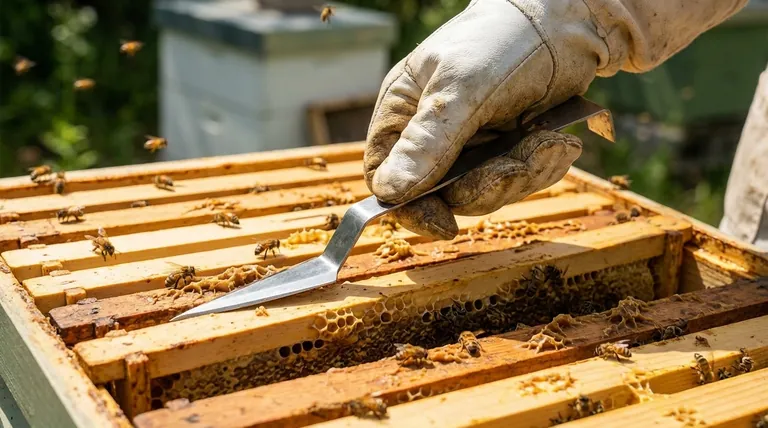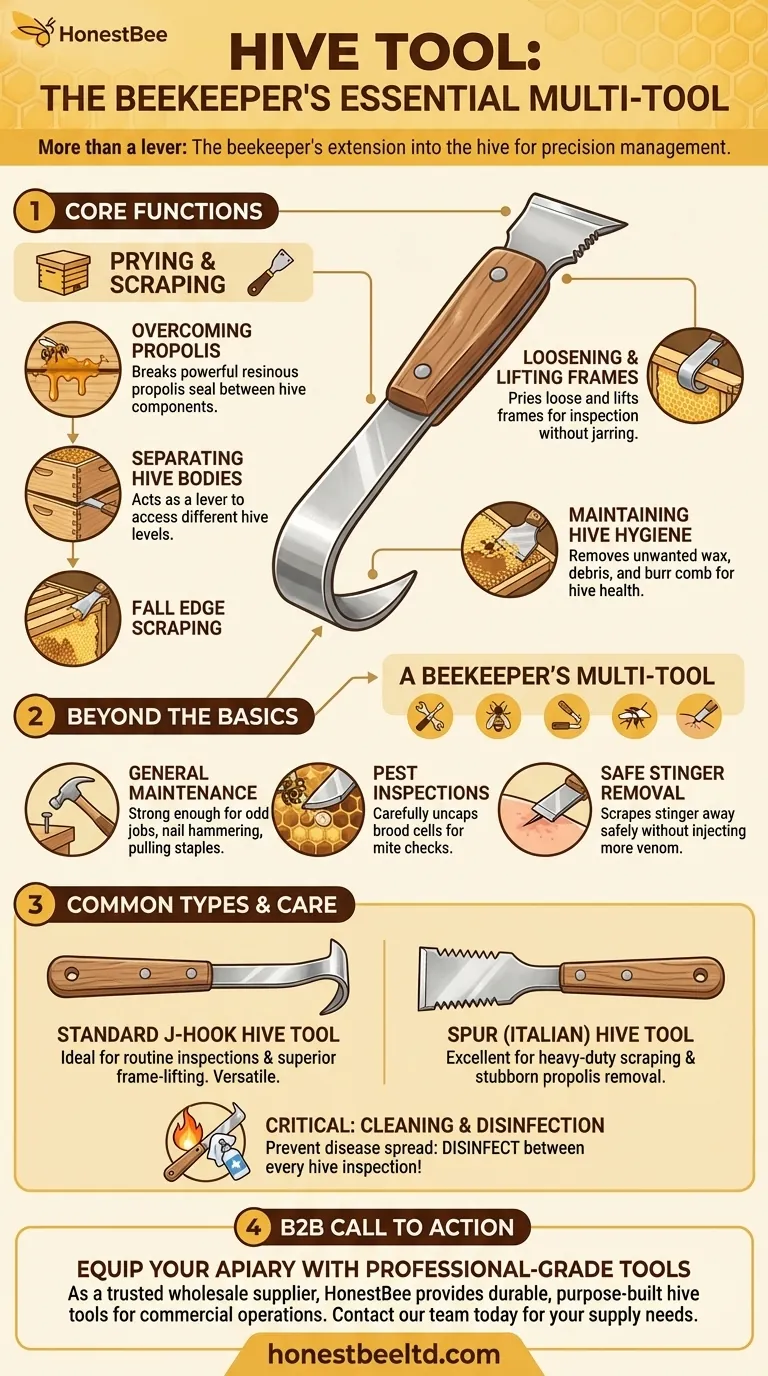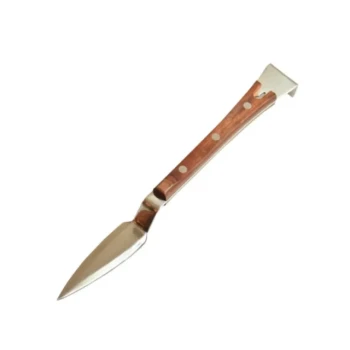A hive tool is the single most essential piece of equipment for any beekeeper. It is a simple, multi-purpose steel bar designed primarily to pry apart hive components and scrape away excess wax and propolis—a resinous "bee glue" that bees use to seal their hive. Without it, performing even the most basic hive inspection would be nearly impossible.
A hive tool is more than a simple lever or scraper; it is the beekeeper's extension into the hive. It allows you to overcome the bees' powerful natural sealants and manage the colony with precision and minimal disruption.

The Core Functions: Prying and Scraping
The work of a beekeeper constantly involves battling the natural tendencies of honeybees. A hive tool is purpose-built to overcome the two biggest physical challenges: propolis and excess comb.
Overcoming Propolis: The Bee's Glue
Bees use a sticky, resinous substance called propolis to seal every crack and gap in their hive. This creates a powerful, anti-microbial bond that makes hive components incredibly difficult to separate by hand.
Separating Hive Bodies
The hive tool's primary prying function is to act as a lever. It is inserted between hive boxes (known as supers) to break the propolis seal, allowing you to access different levels of the colony for inspection or honey harvesting.
Loosening and Lifting Frames
Inside the hive, frames are often glued to the hive box and to each other with both propolis and wax. The tool is used to gently pry them loose and then lift them out for inspection without jarring the colony or damaging delicate honeycomb.
Maintaining Hive Hygiene
The flat, sharp edge of the tool is perfect for scraping away unwanted burr comb, excess wax, and other debris from frames, boxes, and the hive's bottom board. This cleanup is essential for hive health and proper spacing.
Beyond the Basics: A Beekeeper's Multi-Tool
While prying and scraping are its main jobs, the robust nature of the hive tool makes it an indispensable multi-tool in the bee yard.
General Hive Maintenance
The hive tool is strong enough for various odd jobs. Many beekeepers use it to bang in a loose nail, pull out staples, or even clean mud off their boots.
Assisting with Pest Inspections
A beekeeper can use the sharp edge to carefully uncap a few drone or worker brood cells. This is a key diagnostic technique for checking for internal pests like Varroa mites.
Removing Bee Stingers Safely
If you are stung, you should never pinch a stinger to pull it out, as this injects more venom from the attached venom sac. The hive tool's flat edge is perfect for scraping the stinger away cleanly and safely.
Common Hive Tool Types and Considerations
Not all hive tools are identical. The two most common designs are suited for slightly different approaches to hive management.
The Standard (J-Hook) Hive Tool
This is the most popular type, featuring a flat, chisel-like blade on one end and a curved "J" hook on the other. The hook is exceptionally useful for hooking under a frame's top bar to lift it with excellent leverage and control.
The Spur (Italian) Hive Tool
This tool is typically wider and heavier, with a beveled edge for prying on one end and a spur or serrated edge on the other. It excels at heavy-duty scraping tasks but offers less finesse for lifting individual frames.
The Critical Need for Cleaning
A dirty hive tool is a primary vector for spreading devastating bee diseases, such as American Foulbrood, between colonies. It is absolutely essential to clean and disinfect your tool after inspecting each hive to protect your bees.
Making the Right Choice for Your Goal
Your choice of hive tool can be tailored to your beekeeping style and needs.
- If your primary focus is routine inspections: A standard J-Hook tool is the ideal choice for its versatility and superior frame-lifting capability.
- If your primary focus is hive cleanup and maintenance: The wider blade and scraping spur of an Italian-style tool will make removing stubborn propolis and burr comb much more efficient.
- If your primary focus is managing multiple apiaries: Carry both types of tools and a sanitation kit (e.g., a blow torch or rubbing alcohol) to prevent any cross-contamination between hives.
Mastering the use of a hive tool is the first step toward becoming a confident and effective beekeeper.
Summary Table:
| Hive Tool Function | Key Use Case |
|---|---|
| Prying | Separating hive boxes and frames sealed with propolis. |
| Scraping | Removing excess wax, burr comb, and debris for hive hygiene. |
| Lifting | Safely removing frames for inspection with the J-Hook end. |
| Multi-Purpose | Assisting with pest checks, stinger removal, and general maintenance. |
Equip your apiary with professional-grade hive tools from HONESTBEE.
As a trusted wholesale supplier for commercial apiaries and beekeeping equipment distributors, we provide the durable, purpose-built tools you need to manage your colonies efficiently and hygienically. Our range of standard J-Hook and Italian-style hive tools is designed to meet the rigorous demands of professional beekeeping.
Contact our team today to discuss your supply needs and discover how our equipment can support the health of your hives and the success of your operation.
Visual Guide

Related Products
- HONESTBEE Professional Long Handled Hive Tool with Precision Cutting Blade
- HONESTBEE Advanced Ergonomic Stainless Steel Hive Tool for Beekeeping
- HONESTBEE Premium Italian Style Hive Tool with Hardwood Handle
- Professional Dual-End Stainless Steel Hive Tool for Beekeeping
- Professional Multi-Function Stainless Steel Hive Tool
People Also Ask
- What is the hive tool used for? The Essential Multi-Tool for Every Beekeeper
- What are the features of a regular hive tool? The Essential Multi-Tool for Every Beekeeper
- What is a hive tool used for in beekeeping? Your Essential Guide to Hive Management
- What are some common uses of a hive tool? Essential Multi-Purpose Tool for Every Beekeeper
- Why do hive tools have a hole? Unlock the Secret to Efficient Beekeeping



















